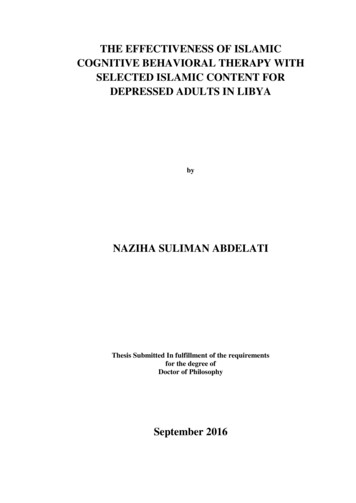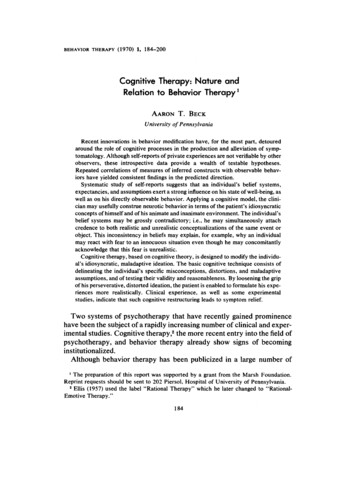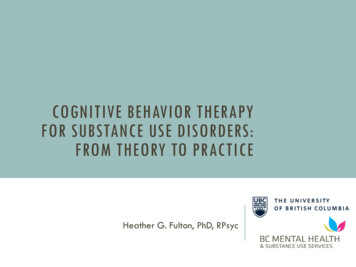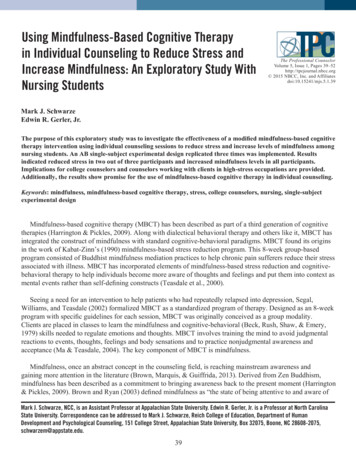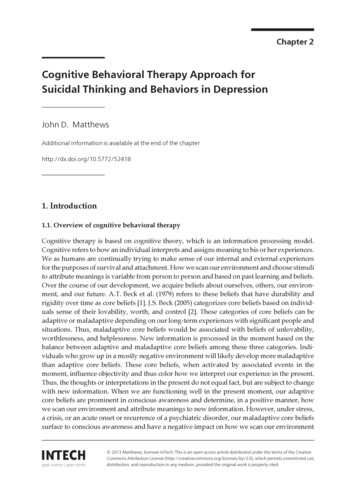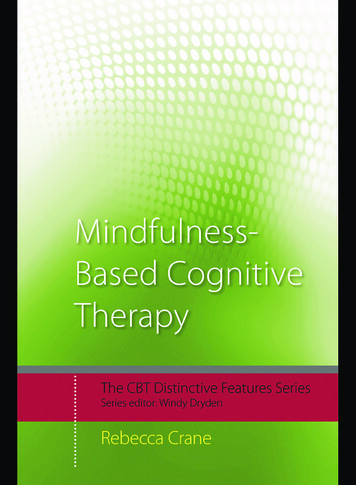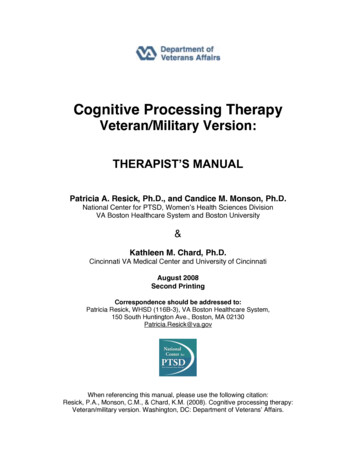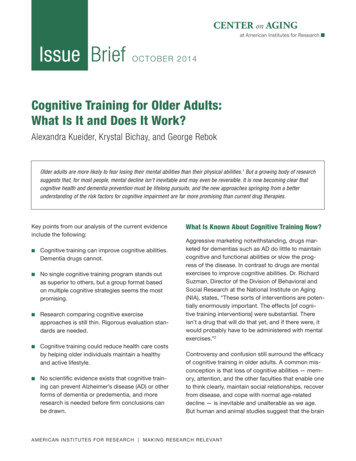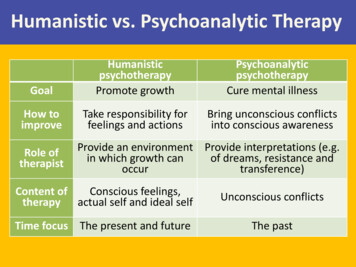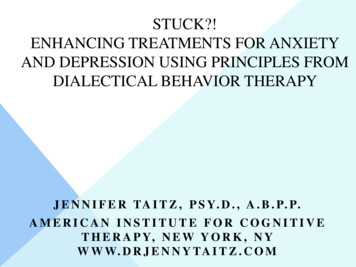
Transcription
Cognitive Processing Therapy:What is Next?Patricia A. Resick, Ph.D., ABPPDuke Universitypatricia.resick@duke.edu
Purpose of TalkThis program will briefly describe cognitive processing therapyand it’s variants as well as to describe how it has evolved overtime, especially in the context of the VA disseminationproject.Recent findings and ongoing or new research projects will bedescribed so that participants will see where CPT is headingover the next 5-10 years.
COGNITIVE PROCESSINGTHERAPY (CPT) IS a short-termevidence-basedtreatment for PTSDa specific protocolthat is a form ofcognitive behavioraltreatmentpredominantlycognitive and mayor may not include awritten accounta treatment that canbe conducted ingroups, individually,or combination3
FORMATS FOR CPTCPT(includes written traumaaccount)CPT-C(No written account) Group Individual Combination Individual Group CombinationIn new book, CPT is the version without accounts; CPT A is with accountsResick, Monson & Chard (in press) Cognitive Processing Therapy for PTSD: AComprehensive Manual. New York: Guilford.4
CPT AVERSUSCPT1.Introduction and Education1.Introduction and Education2.Meaning of the Event2.Meaning of the Event3.Identification of Thoughts and Feelings(ABC)3.Identification of Thoughts and Feelings(ABC)4.Remembering Traumatic Events4.Identification of Stuck Points (ABC)5.Remembering Traumatic Events5.Challenging Questions6.Challenging Questions6.Patterns of Problematic Thinking7.Patterns of Problematic Thinking7.Challenging Beliefs Worksheet8.CBW & Safety Issues8.Safety Issues9.Trust Issues9.Trust Issues10.Power/Control Issues10.Power/Control Issues11.Esteem Issues11.Esteem Issues12.Intimacy Issues and Meaning of the Event12.Intimacy Issues and Meaning of the Event
RANDOMIZED CONTROLLEDTRIALS OF CPTInterpersonal TraumasRape (Resick et al., 2002)Child sexual abuse (Chard,2005)Rape and physical assault(Resick et al., 2008)Interpersonal Trauma(Galovski et al., 2012)DRC, rape victims (Bass et al.2013)Interpersonal Trauma, Sleeptrial (Galovski et al., 2016)Mixed (e.g., interpersonal,accident) (Butollo et al. 2016)Military/VeteransU.S. veterans (Monson et al.,2006)Australian veterans (Forbes et al.,2012)U.S. veterans with military sexualtrauma (Suris et al., 2013)US Veterans (Morland et al.2014).Active Duty (Resick et al., 2015)US Veterans (Maieritsch et al.,2015)US Veterans and communitywomen (Morland et al., 2015)
Interpersonal/Mixed Trauma SamplesStudyTXSample onResick et al.(2002)N 171IndCPT A62 rape survivors (86% of totalhad other crimes)MDD: 44%SAD: 0%Female32 yPE, DelayedtreatmentChard (2005)N 82Grp IndCPT A36 adult CSA survivors (57%recall 100 incidents)MDD: 40%SAD: 1%Female33 yDelayed treatmentEnhanced, 17-wkprotocolResick et al.(2008)N 150IndCPT A53 rape or non-sexual assaultvictimsMDD: 50%SAD: 4%Female35 yCPT, WrittenAccount(i.e., Dismantlingstudy)Galovski et al.(2012)N 100IndVLCPT A53 adult interpersonal traumasurvivorsMDD: 48%SAD: 0%69%Female38ySymptomMonitoring DelayedtreatmentBass et al.(2013)N 405GrpCPT157 sexual violence survivors inDemocratic Republic of Congo(sample randomized by village)unavailableFemale37yIndividual SupportGalovski et al.(2016)N 108Hypnosis IndCPT A52 adult interpersonal traumasurvivors with sleep problemsMDD: 46%SAD: 1%Female37ySymptomMonitoring CPT AButollo et al.(2016)N 148VariablelengthGestalt vCPT A67 German adults with PTSDfrom mixed traumasAffective 52%Anxiety 49%Somatoform 15%67%FemaleDialogical ExposureTherapy (Gestalt)
Military/Veteran SamplesStudyTXSample onMonson et al.(2006)N 60IndCPT A30 US veterans with militarytrauma(78% Vietnam War)MDD: 53%SAD: 3%93% Male55 yTreatment as usualForbes et al.(2012)N 59IndCPT A30 Australian veterans withmilitary trauma(67% Vietnam War)MDD: 80%SAD: 43%93% Male53 yTreatment as usualSuris et al.(2013)N 86IndCPT A52 US veterans with militarysexual traumaunavailable85%Female46 yPresent CenteredTherapyGrp CPTTelemedicine61 US Veterans(67% Vietnam)MDD: 33%SAD: 17%Male56yIn person CPT56 US Active Duty Militaryunavailable93% Male32yPresent CenteredTherapy45 OIF/OEF US VeteransMDD: 44%SAD: 4%93% Male31yIn Person CPT63 Women(20% Veterans)MDD: 30%SAD: 3%Female46yMorland et al.(2014)N 125Resick et al.(2015)N 108GrpCPTMaieritsch et al.(2015)N 90Ind CPT ATele-MedicineMorland et al.(2015)N 126Ind CPTTelemedicineIn person CPT
A RANDOMIZED CLINICAL TRIAL TODISMANTLE COMPONENTS OF CPT FORPTSD IN FEMALE VICTIMS OFINTERPERSONAL VIOLENCEPATRICIA RESICK, TARA GALOVSKI, MARY UHLMANSIEK,CHRISTINE SCHER, GRETCHEN CLUM, YINONG YOUNG-XU2008, JCCP
Dismantling StudyParticipantsTrauma HistoryChronicity Co-morbidity150 WomenMajority with multipletraumas: Adult Sexual Assault:(80.7%) Adult Physical Assault:(84.1%) Domestic Violence:(60.7%) Child Physical Abuse:(73.8%) Child Sexual Abuse:(78.1%)Average timesince indextrauma:14.6 yearsIndex Event: Adult Sexual Assault(31.3%) Child Sexual Assault(38%) Adult Physical Assault(23.3.%) Child Physical Assault(7.3%) 50% Depression 20% PanicDisorder Minimal SubstanceAbuse (2 women) Not currentlySuicidal/Homicidal/Psychotic10
Dismantling Study ConditionsCPT A 12 sessions/60min/2x week Full ProtocolCPT-Cognitive only(CPT)Written Account(WA) 12 sessions/ 60min/2x week Removed thewritten account (2sessions) Extra time spentreviewing cognitivetherapycomponents 7 sessions/ 1stweek was two 60minute sessions; 5,120-min weeklysessions 1-hour writingaccount 1-hourreading/processingwith therapist11
RANDOM REGRESSION OF PDS35CPT 5week6post-treatment 6 mo follow-up12
Manualized Therapy for PTSD:Flexing the Structure ofCognitive Processing TherapyTara E. Galovski, Leah M. Blain, Juliette M.Mott, Lisa Elwood, and Timothy Houle , JCCP,2012
Completer is defined when individuals reach good end statefunctioning. Can we improve outcomes by better tailoringthe dose of therapy?Objective: Determine howmany sessions were needed toreach “good end statefunctioning” (i.e., PDS 20 &BDI-II 10)Modified version of CPT A Treatment continued untilparticipant reached goodend state functioning 18 sessions max Could end before 12sessions (standard # ofsessions)Number of sessions to goodend-state functioning8%26%58%8%earlylate12 sessionsnon-responders
DisseminationVA- largest and first dissemination project.Workshops, Case Consultation, on-line enhancement course,advanced lectures that are posted on SharePoint.Moved from centralized training to regional.Provider roster:Workshop, at least two cases or a group, case consultation,program evaluation3384 VA and Vet Center clinicians are rostered.Since then, VA systems in Canada (Monson) and Australia(Forbes) have also implemented dissemination projects aswell.(Kaysen) Implementation trial in North Kivo, Congo
Non-VA disseminationStatewide programsExamples: Texas, Oklahoma, Pennsylvania, Wyoming (likethe VA program)North Carolina: Learning CollaborativeLeadership engagement throughoutApplication processOn-line course (MUSC course)Workshop (n 60)Weekly consultation calls, monthly affinity call(everyone on the call with a specific topic)Two other workshops during the yearGoal is quality-rated provider level (pass recordedsessions with fidelity ratings)
More local trainingsCounty or city-wide trainings or UniversitiesExamples: Imperial County, CAUniversity of Buffalo, Rutgers Counseling CenterBecause of requests by individuals we (Resick,Chard, Monson) are trying to provideworkshops and two levels of provider rosterProviderQuality-rated providerwww.CPTforPTSD.com
Research on DisseminationThere have been a number of articles examiningparticipants or records reviews of dissemination efforts.There is also research on the dissemination processitself.Monson: Studied dissemination of CPT in VA in CanadaMarques: Examining the iterative process of disseminatingCPT among Latinos in BostonWiltsey-Stirman is studying the use of worksheet review tosee if it can be used to determine fidelity as well aslistening to recorded sessions (not efficient for largenumbers of trainees).
Current RCT ProjectsAll randomized controlled trials unless otherwisementioned
STRONG STAR Consortium(Resick) Group versus Individual CPT(Peterson & Resick) In-home versus in-office versus telehealthequipoise design(Resick and Wachen) Variable length CPT (not an RCT)Up to 24 sessions to get to good end-statePredictors of length and outcome of therapy includeneuropsychological testing (cognitive flexibility),internalizing/externalizingOther demographics and military variables.(Sloan) Written Exposure Therapy versus CPTFive sessions of written exposure (no processing, no homework).CPT is control condition.
Consortium to Alleviate PTSD (CAP)(McGeary & Penzien) Posttraumatic headache study(patients from polytrauma clinic at VA)Comparing headache treatment, CPT, and TAU(Taylor and Resick) CPT and CBTi for PTSD andInsomnia/nightmaresCBTi for 6 weeks (weekly), then CPT for 6 weeks (2/wk)CPT for 6 weeks(2/wk), then CBTi for 6 weeks (weekly)CPY for 6 weeks (2/wk), then more CPT (weekly)Sleep studies and actigraphy as well as PTSD assessment.
Other comparative studies(Schnurr, Chard & Ruzak) CERV- PTSD: CSP591Comparison of CPT A and PE as trained andimplemented in VA900 patients at 17 sites. 4 therapists at each site.Variable length by 2 sessions either way.(Sloan) WET vs. CPT A with civilians andveterans(Chard) CPT A versus PCT among veterans.
PTSD and Comorbidity(Watkins and Beckham) The effects of CPT on cardiacfunctioning.(Pearson) Native American Women with PTSD and AUD;CPT vs. waitlist control(Kaysen and Simpson) CPT vs. Relapse Prevention amongmen and women (civilians & veterans) with PTSD andAUD.(Dedert) smoking cessation versus smoking cessation withconcurrent CPT for PTSD smoking
International(Bohus & Steil) RCT for PTSD and borderlinepersonality.4 site German study, up to 36 sessionsDBT skills, then PE versus variable length CPT.(Rosner & Steil) Adolescent CPT vs generalcounseling(Ito). Japanese RCT comparing CPT withRogarian therapy.
CPT ResourcesFOR INDIVIDUAL ORGROUP MANUAL ORPATIENT MATERIALSINFO ON WORKSHOPS www.CPTforPTSD.comNON-VA PROVIDERROSTERCPTwebIntroductory Video http://cpt.musc.eduWhite board intro www.ptsd.va.gov/public/index.aspFree download of CPTCoach in iTunes CPT coach includes all of theassignments, reminders, etc.
67 German adults with PTSD from mixed traumas Affective 52% Anxiety 49% Somatoform 15% 67% Female Dialogical Exposure Therapy (Gestalt) Interpersonal/Mixed Trauma Samples. Study TX Sample (ITT) Common Comorbidities Gender Age Comparison Condition Monson et al. (2006) N 60 Ind CPT A 30 US veterans with military trauma (78% Vietnam War) MDD: 53%
